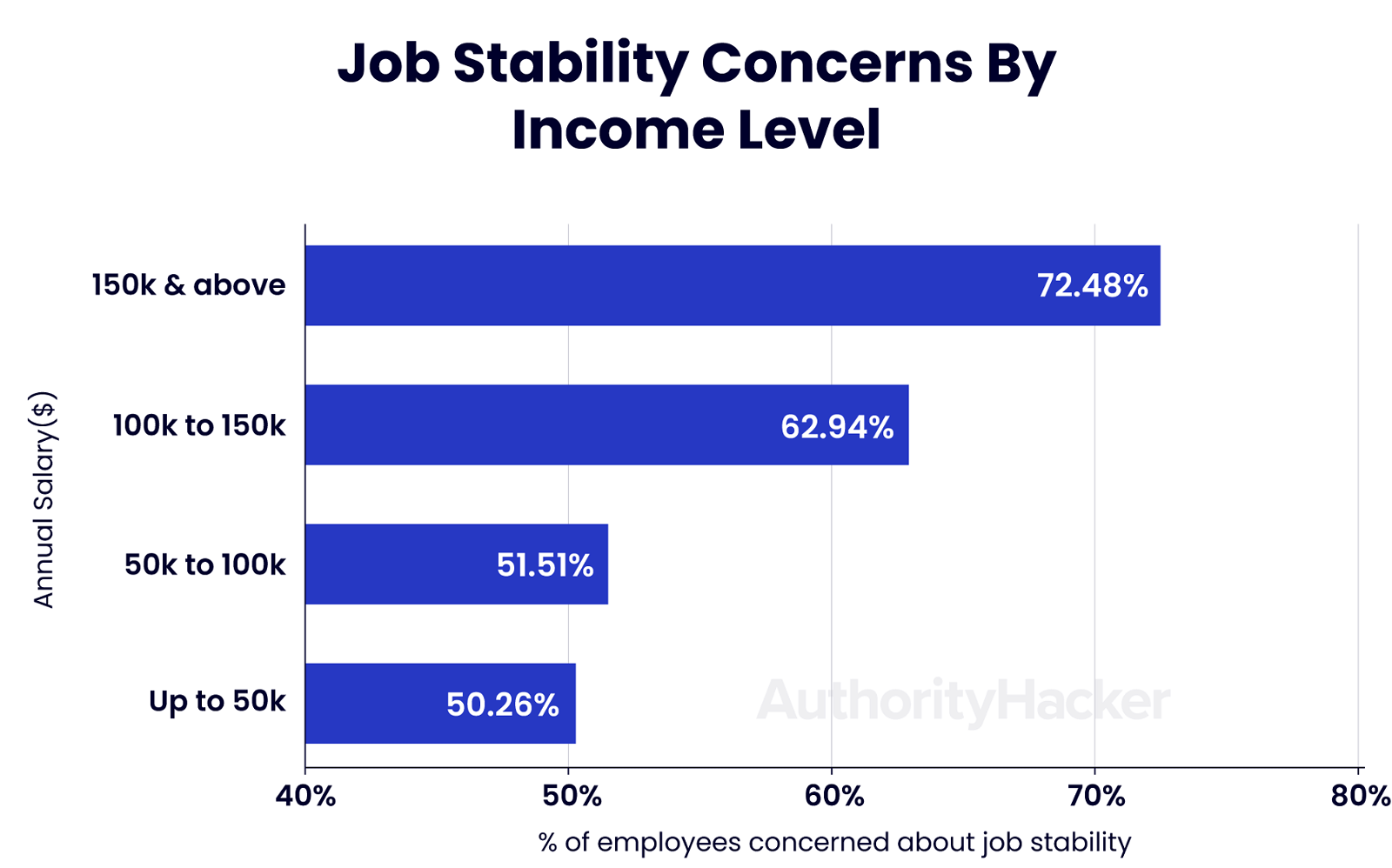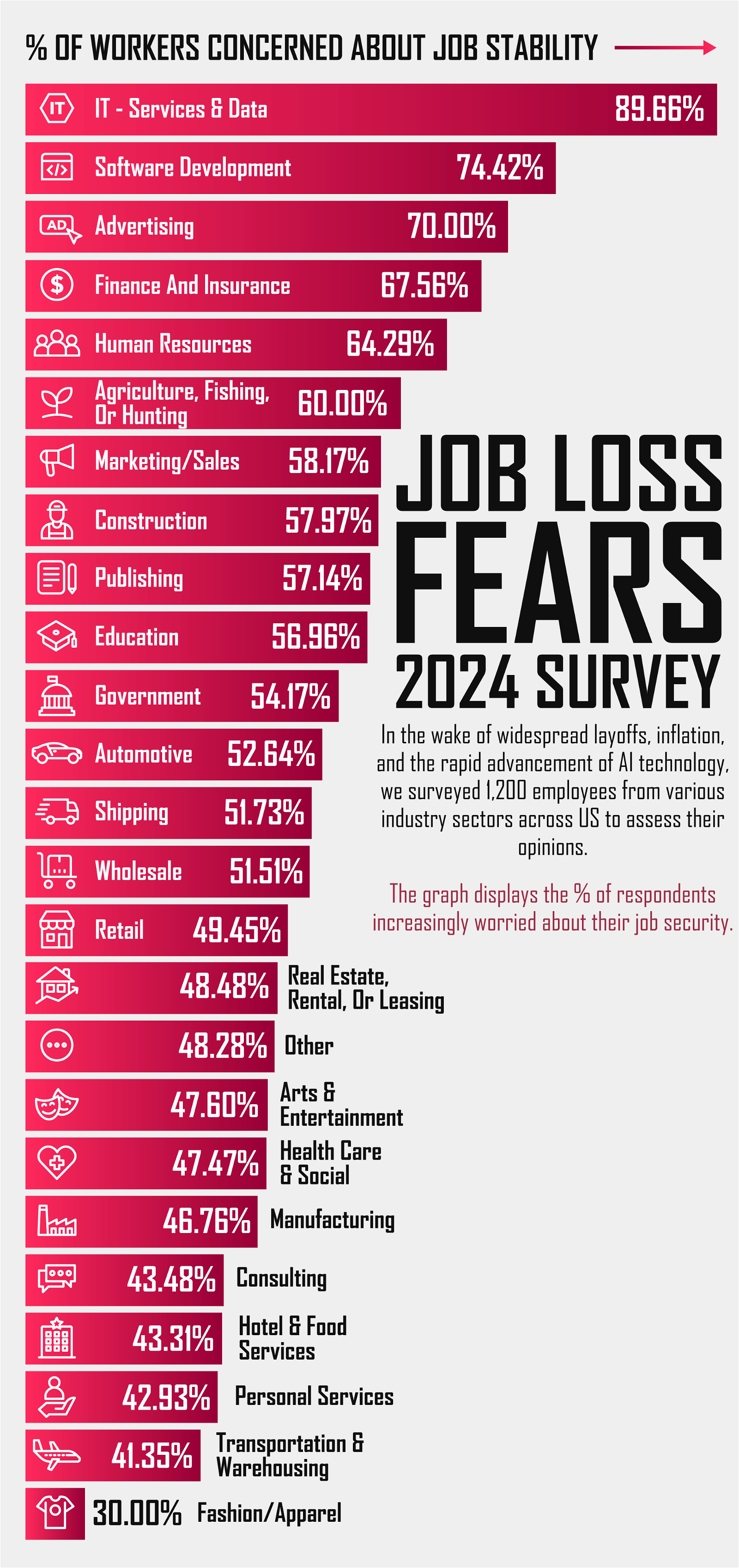In an era defined by rapid technological advancement and economic uncertainty, we embarked on a comprehensive survey to gauge the sentiments of the American workforce regarding job security over the next five years.
Drawing from a meticulously screened pool of 1,200 U.S. residents with full-time employment, we aimed to uncover the underlying anxieties and perceptions shaping the current employment landscape.
Why We Conducted This Study
Our investigation was spurred by the alarming wave of layoffs sweeping across industries — particularly in tech — the speculative yet tangible impact of artificial intelligence on the future of work, and uncertainty surrounding the global economy.
According to Layoffs.fyi, there have been more than 296,000 tech layoffs since 2023, with 33,000 coming in the first 5 weeks of 2024.
Hundreds of large companies — including Google, Amazon, Microsoft, and Spotify — have made headlines for reducing their workforce by up to 25%.
Part of the cause is excessive hiring during the pandemic. Roger Lee, the founder of Layoffs.fyi, told CNN that many tech companies are trying to “correct for their over-hiring during the pandemic surge.”
However, over-hiring isn’t the only cause. Dataminr CEO Ted Bailey — who laid off 20% of staff in November 2023 — states that AI is playing a role in their personnel decisions.
According to a memo shared with TechCrunch, Bailey says that ”recent rapid advancements of their AI platform” contributed to the layoffs.
The uncertainty surrounding the economy is also impacting public perception. While Brian Rose, a senior U.S. economist at UBS, told the New York Times that he predicts a “soft landing” for the U.S. economy after years of COVID-induced inflation, the inflation rate remains high compared to the last decade.
This reality isn’t lost on Americans — a Gallup poll reveals 63% of Americans say the economy is getting worse, with the same amount saying inflated prices pose a moderate or severe financial hardship.
This environment of post-pandemic cuts, uncertainty surrounding the impact of AI, and economic fears prompted us to seek answers: how do full-time U.S. workers feel about their job security amidst these changes?
Unveiling American Workers’ Growing Anxiety
Fear of job loss has rippled across the American workforce — 54.58% of full-time workers have increased concerns about job loss, with 27.08% feeling significant concern.
Our survey cross-referenced these results with a variety of demographic factors, including age, gender, education, income levels, industry, job role, and company size. Here are the most interesting findings:
Men are more concerned than women. Men expressed greater concern (62.87%) than women (47.53%), possibly reflecting the 3:1 male-to-female gender distribution in tech firms.
Higher earners are more concerned. Individuals in the highest income brackets feel most vulnerable, with 75% of those making 125k to 150k and 72.48% of those making 150k and above expressing concern. This may be swayed by the higher salaries in the volatile tech industry.

There’s a generational divide. The concern was most palpable among the 25 to 44 age group, with 62.2% expressing concerns. This showcases a generational divide in job security perceptions, as less than 50% of those 45 and older share their sentiment. Younger people may be more aware of the capabilities of AI and are also more likely to hold less senior positions that may be at increased risk of being cut.
More education = more job security anxiety. Individuals with at least four years of college education express more concern (61.02%) than those with less, possibly due to the higher stakes associated with their roles.
Executives are very concerned. Out of all job roles, high-level roles such as C-level executives (85% concerned) and Directors (78.38% concerned) express the highest levels of concern, which may indicate the visibility people in these roles have regarding the future of their industries.

Workers in larger companies feel particularly vulnerable. Those working in larger companies (500 – 1000 employees) feel particularly at risk (74.33%). This sharply contrasts with the lessened concerns of self-employed workers (42.47%) and those in smaller companies (below 25 employees, 45.38%).
The global economy weighs heavily on most. 73.61% of respondents have increased concerns due to recent global economic trends.
Job Security Concerns By Industry
When we break down job security fears by industry, it’s clear that the tech sector is most concerned. Information — Services And Data (89.66%) and Software (74.42%) are the industries where workers are most concerned about job loss.
This is significantly higher than less tech-centric sectors like Fashion/Apparel (30%), Transportation and Warehousing (41.35%), and Personal Services (42.93%).
This infographic provides a full breakdown of each industry’s level of concern:

AI’s Looming Shadow
A significant portion of respondents (54.58%) anticipate that AI will impact their job security within the next five years.
Sectors that have a high reliance on computer use — like Software (67.44%), Finance (67.57%), and Human Resources (64.29%) — express the highest levels of concern.
In contrast, people in sectors that involve more human-to-human interaction — such as education (43.04%) and real estate (44.68%) — are least concerned about the impact of AI on their livelihoods.
People in IT are noticeably more worried than anyone else. 72.42% of people in IT positions are concerned, with nearly half (48.28%) completely agreeing that AI will affect their job security. Less than 7% believe it won’t have any impact.
These fears may be warranted, as the nature of how we work is quickly shifting. A study from OpenAI estimates that 19% of U.S. workers could see 50% of their workplace tasks impacted by publicly available GPT-4 technology, and the World Economic Forum Future of Jobs report predicts that 44% of workers’ skills will be disrupted between 2023 and 2028.
In addition, these shifts are likely to impact job security. A report from McKinsey states that 30% of hours currently worked could be automated by 2030, and a Goldman Sachs report suggests that 300 million full-time jobs may be exposed to automation in the coming years.
Recovery From Job Loss
We also asked respondents about their ability to recover from job loss.
If faced with job loss, 42% of full-time workers don’t have enough savings to support them until they find a new job, and 38.58% are not confident in their ability to secure new employment within 3 months.
According to Statista, there are 132.59 million full-time employees in the United States, which means 55.68 million Americans — and their dependents — would have immediate financial struggles if faced with job loss.
This aligns with recent data on the decline in Americans’ emergency savings. According to Bankrate’s 2023 Emergency Savings Report, 49% of adults have fewer savings compared to a year ago, and 22% have no emergency savings at all.
The financial impact of job loss seems less severe in the tech-related industry sectors, where only 29.17% feel financially unprepared for potential unemployment. However, with Statista reporting 3 million U.S. residents working in tech, that still constitutes a million people. 38.89% feel unconfident about finding a new job within 3 months, similar to the other industries’ respondents.
It’s clear that sudden unemployment would cause immediate financial problems for many Americans, and threats to job security from many fronts are causing a majority of workers to feel the weight of that stress.
Potential Paths Forward
The widespread concerns about AI replacing human workers raise an important question: what can Americans do now to AI-proof their careers?
It’s important to note that the proliferation of AI isn’t only set to eliminate jobs — it should also create new opportunities. A World Economic Forum report states that while it may disrupt an estimated 85 million jobs by 2025, the new technology may simultaneously create 97 million new jobs. Workers who learn to use AI now may have an easier time taking advantage of these new positions.
While the rapid advancement of AI technology makes it hard to provide concrete guidelines for AI upskilling, Harvard Business Review and Fast Company have a few suggestions:
- Become familiar with available AI tools and integrate them into your workflow.
- Hone soft skills that machines strive to emulate, such as communication and empathy.
- Build strong relationships with colleagues and peers.
- Cultivate unique expertise and develop your personal brand.
An IBM study also found that 87% of executives believe job roles are more likely to be augmented than replaced by generative AI, lending further credence to AI upskilling as a safeguard against unemployment.
For those who are still choosing a career — or are open to a change — it may also be worthwhile to explore careers that are least likely to be automated. The U.S. Career Institute has compiled a list of 65 jobs with a projected 0% risk of being automated, with options including careers in medicine, social services, engineering, public service, and education.
We surveyed 1,200 vetted US full-time employees spanning a diverse range of industries to capture a comprehensive snapshot of the American workforce’s sentiments on job security.
Our survey also captured full demographic profiles of all respondents, allowing us to cross-reference data with a variety of demographic data, including:
- Gender
- Education level
- Income level
- Ethnicity
- Age
- Job role
- Industry
- Company size
Here is a demographic breakdown of the survey participant:
Gender
- Male: 46%
- Female: 54%
Age
| 25 – 34 | 26.50% |
| 35 – 44 | 23.83% |
| 45 – 54 | 16.50% |
| > 54 | 20.42% |
Ethnicity
| Asian | 3.50% |
| Black | 12.50% |
| Hispanic | 3.58% |
| Latino | 1.67% |
| White | 67.42% |
| Multiracial | 2.75% |
| Other | 4.00% |
| Prefer not to say | 3.42% |
Education
| High school | 30.25% |
| Vocational/Technical college | 18.00% |
| University | 29.17% |
| Post-graduate | 16.58% |
Income Levels (Per Year)
| Between $25,000 and $49,999 | 22.33% |
| Between $50,000 and $74,999 | 18.58% |
| Between $75,000 and $99,999 | 15.42% |
| Between $100,000 and $124,999 | 9.33% |
| Between $125,000 and $149,999 | 8.67% |
| $150,000 or more | 9.08% |
| Prefer not to say | 2.25% |
Company Size
| 2-5 | 7.17% |
| 6-10 | 6.42% |
| 11-25 | 7.17% |
| 26-50 | 9.08% |
| 51-100 | 9.25% |
| 101-250 | 7.25% |
| 251-500 | 10.50% |
| 501-1000 | 12.33% |
| 1001-5000 | 8.83% |
| Greater than 5000 | 11.33% |
| Prefer not to say | 1.67% |
Implications of Study
Our study shows the American workforce has widespread concerns about job security, especially among tech workers, younger workers, higher earners, and those at larger companies.
These concerns are fueled by recent layoffs, the prospect of widespread AI automation, and a perception of instability underpinning the global economy.
AI automation is a particularly concerning threat to job security, with prominent companies predicting AI will be able to automate many tasks and roles. Computer-based jobs seem particularly vulnerable to augmentation or replacement.
Coupled with the inability of many Americans to cope financially with a loss of employment, it’s clear that potential hardship may lie ahead for the average American.
However, early movers who adapt their skills to include AI use or switch to careers unlikely to be affected by AI will likely have a smoother transition into the new era of work.





